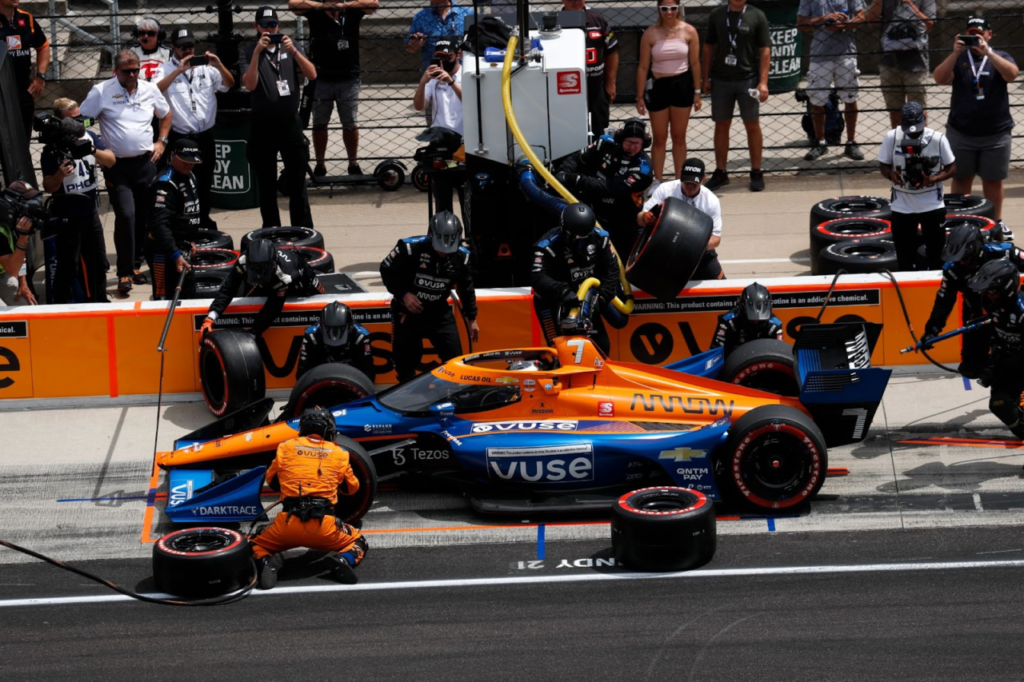In the fast-paced world of racing, every second counts. Pit stops play a crucial role in a team’s success, and having the right motorsport pit equipment is essential for maximising efficiency and maintaining a competitive edge. This guide aims to provide a comprehensive overview of racing pit equipment, including its importance, key components, and best practices for optimising performance.

The Importance of Racing Pit Equipment:
Pit stops are strategic moments during races where teams can refuel, change tyres, and make crucial adjustments to their vehicles. Efficient pit stops can make or break a race, as they directly impact a team’s overall performance. Investing in high-quality pit lane and crew equipment enhances safety, streamlines operations, and minimises downtime, ultimately leading to improved results.
Also inside the racing pit garage, various equipment is needed to support the racing team’s operations and ensure smooth and efficient performance during races.
Essential Motorsport Pit Equipment
Jacks and Lift Systems
Jacks and lift systems are crucial for quickly and safely lifting race cars off the ground during a pit stop. Hydraulic jacks are commonly used due to their ability to generate significant lifting force with minimal effort. These jacks often feature a quick-lift mechanism, allowing the car to be rapidly elevated, the Sealey “Rocket Lift” jacks being a good example.
For the bigger budget teams air jacks are often used instead as these are very quick to use and offer immediate access to the car for tyre changes or maintenance etc. The speed and reliability of hydraulic and air jacks help reduce the time spent on pit stops, enabling efficient tyre changes, repairs, and adjustments.

Air and Power Tools
Air and power tools are essential for expediting various tasks during pit stops. Pneumatic tools, such as impact wrenches and air ratchets, are primarily used for rapid tyre changes. Their high torque output allows pit crew members to quickly remove and tighten lug nuts, minimising the time the car spends off the ground. Additionally, electric or cordless power tools, such as drills and grinders, assist in repairs and maintenance tasks that require precise and efficient work.
Fuelling Systems
Fuelling systems play a vital role in refuelling the race car efficiently while complying with safety regulations. Fuel rigs equipped with high-flow fuel nozzles enable rapid fuel delivery, minimising the time spent refuelling. The catch cans incorporated in the fueling system help prevent fuel spillage and ensure safety during the process. Precise fuel delivery not only saves time but also helps optimise the vehicle’s performance and fuel consumption during the race.

Tyre Management
As well as choosing the correct tyre for your application it’s important to also have the correct racing pit equipment in the garage. Tyre management equipment is crucial for organising and maintaining the race car’s tyres during race meets. Tyre warmers, tyre trolleys and racks provide a convenient and efficient way to store and transport multiple sets of tyres, ensuring quick access when needed.
Pressure gauges and durometers allow pit crew members to accurately measure tyre pressure and make necessary adjustments. Automated tyre changers, wheelguns and wheel balancers further enhance efficiency by streamlining the process of changing tyres and optimising wheel balance, leading to improved performance on the track.

Diagnostic and Testing Equipment
Racing teams utilise specialised diagnostic tools, such as engine analysers, data loggers, and temperature and sound measuring devices, to assess the car’s performance, identify issues, and fine-tune various parameters. These tools provide valuable data and insights that inform the team’s decision-making process, enabling them to optimise the vehicle’s setup and performance.
Specialty Tools
Specialty tools cater to specific components and systems of the race car which address unique maintenance and adjustment requirements. Suspension setup tools, such as camber and caster gauges, assist in fine-tuning the car’s suspension geometry to optimise handling and stability. This can be a very tricky area to get right for your car, a suspension guide is what you need! Alignment gauges aid in ensuring precise wheel alignment, crucial for maintaining consistent performance and tyre wear.
Brake bleeders help remove air from the brake system, ensuring optimal braking performance. Among these you may also need specialised machinery for engine rebuilding, suspension tuning, gearbox servicing, or aerodynamic adjustments. Such equipment allows the team to perform intricate procedures with precision. These specialised tools enable the pit lane crew to fine-tune and optimise specific aspects of the race car, enhancing its overall performance on the race track.
Storage and solutions
Motorsport pit garages require effective storage solutions for spare parts, tyres, fluids, and various consumables. Toolboxes, shelves and paddock trolleys help maintain an organised inventory, reducing the time spent searching for items and promoting efficient workflow. Proper storage also ensures that parts and supplies are kept in optimal conditions, preventing damage or contamination. Also don’t underestimate the importance of workbenches which provide dedicated space for mechanics for any repairs or modifications. Proper organisation of tools and equipment helps maintain a tidy workspace and minimises the risk of misplacement or damage.
These essential equipment components work together to expedite pit stop procedures, enhance safety, and optimise the race car’s performance. From quick-lifting jacks to tyre management equipment and specialised tools, each component plays a vital role in ensuring efficient pit stops and maximising the team’s chances of success in races.

Pit Equipment Keeps you Safe
Safety is paramount in racing pit stops. Alongside the primary pit equipment, teams must have the following safety gear readily available:
Fire Extinguishers
Extinguisher safety in motorsport is critical in the car and the garage. Fire extinguishers address any potential fires that may occur during refuelling or other maintenance tasks. They should be strategically placed at easily accessible locations within the pit area. Pit crew members should be trained in using fire extinguishers effectively and understanding the different types of extinguishers suitable for various types of fires, such as those involving fuel or electrical components. By having fire extinguishers readily available, teams can respond quickly to any fire emergencies, mitigating potential damage and ensuring the safety of both crew members and the race car.

Safety Barriers in the Pits
Safety barriers play a vital role in creating a clear boundary between the pit lane and the racing track. Portable barriers or cones are often used to establish a visible and physical separation, preventing unauthorised personnel or objects from entering the active racing area. These barriers help protect pit crew members from oncoming race cars, ensuring their safety during pit stops. By clearly demarcating the pit area, safety barriers also help maintain a controlled environment and prevent accidents or collisions between crew members, vehicles, and other track personnel.
Protective Gear
Protective clothing is essential for pit crew members and mechanics to minimise the risk of injury during stops and/or maintenance. The following protective gear is typically worn:
- Fire-Resistant Suits: Pit crew members wear fire-resistant suits to protect themselves from potential fires and burns. These suits are made of specialised flame-resistant materials that provide a barrier against heat and flames.
- Helmets: Helmets offer head protection and minimise the risk of head injuries during pit stops. They are designed to withstand impact and provide additional safety measures in case of accidents or flying debris.
- Gloves: Fire-resistant gloves are worn to protect the hands and provide a secure grip when handling hot components, fuel, or tools. They also serve as a barrier against cuts and abrasions.
- Safety Shoes: Important pit crew equipment are safety shoes. These are designed to offer protection against impact, punctures, and heat. These shoes have reinforced toe caps and non-slip soles to ensure stability and reduce the risk of foot injuries.
- Hearing protection: A racetrack can be a noisy place, whether it be cars, wheelguns or maintenance tools. It’s important to protect your ears from the dangers of long term damage due to being exposed to loud noises. For drivers the use of ear plugs is needed and for mechanics and pit crew earplugs or noise cancelling headphones are used to reduce the potential damage.

By equipping pit crew members with the appropriate protective gear, racing teams prioritise their safety and reduce the risk of injuries during stops. This allows the crew to focus on their tasks with confidence, knowing that they have the necessary protection against potential hazards present in the pit lane environment.
Best Practices for Race and Pit Stop Efficiency
To optimise pit stop performance, teams should consider the following guidelines:
Pit Products for Regular Maintenance
Regular maintenance of pit equipment is essential to ensure its optimal performance and reliability. Teams should establish a maintenance schedule and conduct routine inspections to identify any signs of wear, damage, or potential malfunctions. This includes checking hydraulic jacks for leaks or faulty seals, inspecting air and power tools for proper functionality, and verifying the integrity of fuelling systems. Any identified issues should be promptly addressed through repairs or replacements to prevent unexpected equipment failures during critical pit stops.

Train and Communicate Effectively with the Right Pit Equipment
Thorough training sessions are crucial for the pit crew to perform their roles efficiently and safely. Training should focus on coordination, precision, and adherence to safety protocols. Pit crew members should be familiar with the operation and proper handling of pit equipment, including tools, jacks, and fuelling systems. Effective communication during pit stops is essential for seamless teamwork. Clear and concise communication ensures that tasks are executed precisely and in a synchronised manner, minimising errors and optimising overall performance.
Enhance Your Pit Stop Strategy
Developing a well-defined pit stop strategy is key to maximising efficiency and gaining a competitive advantage. Crew members need to consider factors such as fuel consumption, tyre wear, and race conditions when determining the optimal timing for pit stops. Simulations and data analysis play a significant role in making informed decisions about when to refuel, change tyres, or perform necessary adjustments. By strategically planning pit stops, teams can minimise time spent in the pit lane while optimising the race car’s performance throughout the race.

Streamlining Processes
Efficiency can be significantly improved by continuously analysing and refining pit stop procedures. Pit crews should review video footage or conduct time-motion studies to identify areas where unnecessary movements or delays occur. This analysis helps identify opportunities to streamline processes and eliminate any redundant steps or inefficiencies. By optimising pit stop workflows, teams can reduce the overall time spent in the pit lane, giving them a competitive edge and potentially gaining crucial positions during races.
Performance Monitoring
Utilising technology for performance monitoring allows teams to gather data and make data-driven improvements. Time-tracking systems provide accurate measurements of pit stop durations, helping identify areas for improvement and benchmarking performance against competitors. Video analysis enables a detailed examination of the pit stop process, allowing crews to identify potential bottlenecks or areas where coordination and efficiency can be enhanced. By monitoring and analysing performance metrics, teams can implement targeted changes and optimise their pit stop strategies to shave off valuable seconds during races.
By incorporating these guidelines into their pit stop practices, racing teams can enhance efficiency, reduce errors, and maximise their overall performance on the track. Continuous improvement efforts in maintenance, training, strategy development, process streamlining, and performance monitoring contribute to the team’s success and their ability to compete at the highest level.
The Race Never Stops
In the world of racing, pit stops can be the deciding factor between victory and defeat. Equipping your team with the right equipment and ensuring optimal performance is essential for achieving success. By investing in high-quality pit equipment, prioritising safety, and implementing efficient practices, racing teams can boost their overall performance and gain a competitive edge on the track.
Enjoyed this? Read more of our latest news:
- Step By Step Guide To Get A Motorsport Licence
- Why Was The Super Touring Car Era So Iconic
- What you need to know in Motorsport 2023
Where To Next?
Looking for the latest motorsport parts and accessories? Check out our wide range from top brands.
Come and visit us at our store, showroom and fitting centre in Wrexham.
Want to know more about our story? Learn about who we are and why we’ve been driven by passion for over 50 years.
Interested in everything we do? Catch up on all the latest Demon Tweeks news.





It’s great that you mentioned how efficient pit stops could make or break a race since they could directly impact a team’s overall performance. I was watching a race last night and it was quite fascinating to see when the cars do pit stops. It seems pit stops usually have various equipment in them, like racing flight cases.